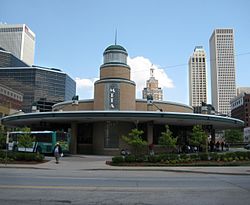| | |
| Parent | City of Tulsa |
|---|---|
| Founded | 1968 |
| Headquarters | 510 South Rockford, Tulsa |
| Locale | Tulsa, Oklahoma |
| Service area | Tulsa, Jenks, Broken Arrow, and Sand Springs |
| Service type | bus service, paratransit, express bus service |
| Routes | 18 |
| Hubs | 2 Transit Centers 13 Park and Rides (locally called "Park-N-Save lots") |
| Fleet | 141 buses and vans |
| Daily ridership | 6,491 (weekdays, 2023) [1] |
| Annual ridership | 1,991,867 (2023) [1] |
| General manager | Scott Marr |
| Website | metrolinkok |
MetroLink, officially the Metropolitan Tulsa Transit Authority (MTTA), is the public transit system operating buses and paratransit for Tulsa, Oklahoma, United States. It has 18 routes and several microtransit zones that serve Tulsa. The system has two major hubs: Memorial Midtown Station at 7952 E. 33rd St. in Midtown Tulsa, and the Denver Avenue Station at 319 S. Denver across from the BOK Center in Downtown.
Contents
The Metropolitan Tulsa Transit Authority was formed in 1968 and adopted the brand name Tulsa Transit in 1980. It was renamed to MetroLink in 2024. [2]

